Thermo-economic performance analysis of two novel isobaric liquid carbon dioxide energy storage systems coupled with pumped hydro storage
IF 9.9
1区 工程技术
Q1 ENERGY & FUELS
引用次数: 0
Abstract
Liquid carbon dioxide energy storage is a promising technology for stabilizing renewable power output; however, the inefficiency and diseconomy caused by non-isobaric storage are generally overlooked. In response, this study proposes two novel isobaric liquid carbon dioxide energy storage systems coupled with pumped hydro storage, the pumped hydro storage-assisted and high backpressure pumped hydro storage-assisted systems. These systems achieve isobaric storage by incorporating hydraulically designed carbon dioxide-water co-storage tanks. The study begins with a dynamic behavior analysis of the basic system, followed by a thermo-economic performance comparison, parametric analysis, and an economic uncertainty analysis based on multi-objective optimization. Results show that neglecting non-isobaric storage in the basic system leads to a 26.44 % discrepancy in total exergy efficiency, a 59.67 % relative deviation in energy storage density and an economic overestimation. By avoiding unsteady-state operation, the high backpressure pumped hydro storage-assisted system outperforms the other two, achieving a total exergy efficiency, levelized cost of storage and net present value of 52.95 %, 0.131 $/kWh and 32.24 M$, respectively, while the pumped hydro storage-assisted system achieves the highest energy storage density at 3.85 kWh/m3. To further enhance thermo-economic performance, attention can be paid to key components such as compressor, turbine, condenser and tanks. Additionally, the high backpressure pumped hydro storage-assisted system exhibits the most favorable and stable economic performance, with a levelized cost of storage of 0.154 ± 0.022 $/kWh and a net present value of 22.11 ± 9.05 M$. The system economic viability can be further improved by expanding discharge capacity and operating durations, particularly in regions with favorable electricity price structures.
求助全文
约1分钟内获得全文
求助全文
来源期刊

Energy Conversion and Management
工程技术-力学
CiteScore
19.00
自引率
11.50%
发文量
1304
审稿时长
17 days
期刊介绍:
The journal Energy Conversion and Management provides a forum for publishing original contributions and comprehensive technical review articles of interdisciplinary and original research on all important energy topics.
The topics considered include energy generation, utilization, conversion, storage, transmission, conservation, management and sustainability. These topics typically involve various types of energy such as mechanical, thermal, nuclear, chemical, electromagnetic, magnetic and electric. These energy types cover all known energy resources, including renewable resources (e.g., solar, bio, hydro, wind, geothermal and ocean energy), fossil fuels and nuclear resources.
 求助内容:
求助内容: 应助结果提醒方式:
应助结果提醒方式:


